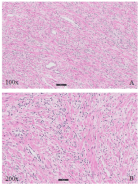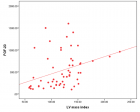Abstract
Research Article
Retinopathy of prematurity - Intersibling divergence of risk factors among twins
Sudeep Navule Siddappa*, Kavitha Chikknayakanahalli Venugopal, Pavana Acharya and Tintu Susan Joy
Published: 19 February, 2020 | Volume 4 - Issue 2 | Pages: 009-011
Retinopathy of prematurity (ROP) is a consequence of an arrest in normal retinal neural and vascular development, which determines the aberrant retinal regeneration [1,2].
ROP is a disease process mostly reported in preterm neonates ranging from mild, transient changes in the retina with regression to severe progressive vasoproliferation, scarring, detachment of retina and blindness and it is common blinding disease in children and a major cause of vision loss among preterm infants [3]. Today it is well known that oxygen therapy is not the single causative factor, but many other risk factors play a causative role in the pathogenesis of ROP [4,5].
The risk factors for ROP include oxygen administration, hypoxia, hypercapnia, blood transfusion exchange transfusion, apnea,sepsis and total parenteral nutrition. The incidence of ROP has been reported to be similar in multiple and singleton births [6-8]. Twin studies show that from 70% to 80% of the susceptibility to ROP is conditioned by genetic factors [9,10].
Hence this study is to find out the incidence of ROP in twins in a tertiary care centre in a developing country. It also attempts to identify the difference in risk factors among twins which predispose to ROP in Neonatal Intensive Care Unit.
Read Full Article HTML DOI: 10.29328/journal.ijceo.1001026 Cite this Article Read Full Article PDF
References
- Hellström A, Smith LE, Dammann O. Retinopathy of prematurity. Lancet. 2013; 382: 1445-1457. PubMed: https://www.ncbi.nlm.nih.gov/pubmed/23782686
- Chen J, Stahl A, Hellstrom A, Smith LE. Current update on retinopathy of prematurity: screening and treatment. Curr Opin Pediatr. 2011; 23: 173-178. PubMed: https://www.ncbi.nlm.nih.gov/pubmed/21150442
- Chen J, Smith LE. Retinopathy of prematurity. Angiogenesis. 2007; 10: 133-140. PubMed: https://www.ncbi.nlm.nih.gov/pubmed/17332988
- Hammer ME, Mullen PW, Fergusson JG, Pai S, Cosby C, et al. Logistic analysis of risk factors in acute retinopathy of prematurity. Am J Ophthalmol. 1986; 102: 1-6. PubMed: https://www.ncbi.nlm.nih.gov/pubmed/3728608
- Seiberth V, Linderkamp O. Risk factors in retinopathy of prematurity. a multivariate statistical analysis. Ophthalmologica. 2000; 214: 131-135. PubMed: https://www.ncbi.nlm.nih.gov/pubmed/10720918
- Schaffer DB, Palmer EA, Plotsky DF, Metz HS, Flynn JT, et al. Prognostic factors in the natural course of retinopathy of prematurity. The Cryotherapy for Retinopathy of Prematurity Cooperative Group. Ophthalmology. 1993; 100: 230-237. PubMed: https://www.ncbi.nlm.nih.gov/pubmed/8437832
- Blumenfeld LC, Siatkowski RM, Johnson RA, Feuer WJ, Flynn JT. Retinopathy of prematurity in multiple-gestation pregnancies. Am J Ophthalmol. 1998; 125: 197-203. PubMed: https://www.ncbi.nlm.nih.gov/pubmed/9467447
- Friling R, Rosen SD, Monos T, Karplus M, Yassur Y. Retinopathy of prematurity in multiple-gestation, very low birth weight infants. J Pediatr Ophthalmol Strabismus. 1997; 34: 96-100. PubMed: https://www.ncbi.nlm.nih.gov/pubmed/9083954
- Bizzarro MJ, Hussain N, Jonsson B, Feng R, Ment LR, et al. Genetic susceptibility to retinopathy of prematurity. Pediatrics. 2006; 118: 1858-1863. PubMed: https://www.ncbi.nlm.nih.gov/pubmed/17079555
- Azad R, Chandra P, Patwardhan SD, Gupta A. Profile of asymmetrical retinopathy of prematurity in twins. Indian J Ophthalmol. 2010; 58: 209-211. PubMed: https://www.ncbi.nlm.nih.gov/pubmed/20413923
Figures:
Similar Articles
-
A Comparative Study of Anatomic and Functional Outcomes of Two Surgical Techniques of Cataract at LomeAyena KD*,Santos KAM,Vonor K,Amedome KM,Wodome A,Strauss G,Nagbe YE,Koffi-Ametooyona A, Balo K. A Comparative Study of Anatomic and Functional Outcomes of Two Surgical Techniques of Cataract at Lome . . 2017 doi: 10.29328/journal.hceo.1001001; 1: 001-008
-
Theory and Experiments. (+) Add Reading Glasses to Prevent MyopiaPeter R Greene*,Brown OS. Theory and Experiments. (+) Add Reading Glasses to Prevent Myopia . . 2017 doi: 10.29328/journal.hceo.1001002; 1: 009-022
-
Efficacy of early Hyperbaric Oxygen Therapy in Central Retinal Artery OcclusionAyse Gul Kocak Altintas*,Mehmet Citirik. Efficacy of early Hyperbaric Oxygen Therapy in Central Retinal Artery Occlusion . . 2017 doi: 10.29328/journal.hceo.1001003; 1: 023-028
-
Mitomycin-C Use and Complications in OphthalmologyTongabay Cumurcu*. Mitomycin-C Use and Complications in Ophthalmology. . 2017 doi: 10.29328/journal.hceo.1001004; 1: 029-032
-
Intravitreal Ranibizumab/ Lucentis (IVTL) injections in Glaucoma patients-Intraocular Pressure (IOP) elevation and the use of Anterior Chamber Paracentesis (ACP)EA Ansari*. Intravitreal Ranibizumab/ Lucentis (IVTL) injections in Glaucoma patients-Intraocular Pressure (IOP) elevation and the use of Anterior Chamber Paracentesis (ACP) . . 2017 doi: 10.29328/journal.hceo.1001005; 1: 033-041
-
Detection of Ganglion Cell Loss in Preperimetric Glaucoma by Fourier-Domain Optical Coherence TomographySuneeta Dubey*, Baswati Prasanth,Lokesh Chauhan, Saptarshi Mukherjee. Detection of Ganglion Cell Loss in Preperimetric Glaucoma by Fourier-Domain Optical Coherence Tomography. . 2017 doi: 10.29328/journal.hceo.1001006; 1: 042-048
-
Intravitreal ranibizumab in the management of acute central serous ChorioretinopathyIbrahim Nawaiseh,Ahmad Halawa*,Dina Alardah. Intravitreal ranibizumab in the management of acute central serous Chorioretinopathy . . 2017 doi: 10.29328/journal.hceo.1001007; 1: 049-054
-
The Role of Omega-3 Essential Fatty Acids in Dry Eye DiseaseWilliam J Faulkner*. The Role of Omega-3 Essential Fatty Acids in Dry Eye Disease . . 2017 doi: 10.29328/journal.ijceo.1001008; 1: 055-059
-
Neuro-ophthalmological emergency disorders: A general viewBurak Turgut*,Feyza Çaliş Karanfil, Fatoş Altun Turgut. Neuro-ophthalmological emergency disorders: A general view . . 2017 doi: 10.29328/journal.ijceo.1001009; 1: 060-066
-
Prospective Clinical Study to Find out Epidemiology of Xerophthalmia in Children in a Tertiary Care Centre in IndiaDeepak Mishra*,Megha Gulati,Prashant Bhushan,Nilesh Mohan,Bibhuti Sinha P. Prospective Clinical Study to Find out Epidemiology of Xerophthalmia in Children in a Tertiary Care Centre in India . . 2017 doi: 10.29328/journal.ijceo.1001010; 1: 066-070
Recently Viewed
-
Impact of Moringa oleifera Leaf Flour supplement on Weight Gain in Moderately Acutely Malnourished Children in BeninLaleye Flora Tinouade Founmilayo*, Fanou Fogny Nadia and Kayode Polycarpe. Impact of Moringa oleifera Leaf Flour supplement on Weight Gain in Moderately Acutely Malnourished Children in Benin. Arch Food Nutr Sci. 2023: doi: 10.29328/journal.afns.1001052; 7: 070-077
-
Drug Rehabilitation Centre-based Survey on Drug Dependence in District Shimla Himachal PradeshKanishka Saini,Palak Sharma,Bhawna Sharma*,Atul Kumar Dubey,Muskan Bhatnoo,Prajkta Thakur,Vanshika Chandel,Ritika Sinha. Drug Rehabilitation Centre-based Survey on Drug Dependence in District Shimla Himachal Pradesh. J Addict Ther Res. 2025: doi: 10.29328/journal.jatr.1001032; 9: 001-006
-
Feature Processing Methods: Recent Advances and Future TrendsShiying Bai,Lufeng Bai*. Feature Processing Methods: Recent Advances and Future Trends. J Clin Med Exp Images. 2025: doi: 10.29328/journal.jcmei.1001035; 9: 010-014
-
Relationship between Vitamin D Deficiency and Lipopolysaccharides Porphyromonas gingivalis Bacteria in Stunting ChildrenErwin Gunawan*,Ria Puspitawati. Relationship between Vitamin D Deficiency and Lipopolysaccharides Porphyromonas gingivalis Bacteria in Stunting Children. Ann Biomed Sci Eng. 2024: doi: 10.29328/journal.abse.1001033; 8: 059-065
-
Addiction to self-strangulation: a case-reportAurely Ameller*,Yann Le Strat,Marion Cadranel,Celine Portalier, Caroline Dubertret. Addiction to self-strangulation: a case-report . J Addict Ther Res. 2017: doi: 10.29328/journal.jatr.1001003; 1: 016-021
Most Viewed
-
Evaluation of Biostimulants Based on Recovered Protein Hydrolysates from Animal By-products as Plant Growth EnhancersH Pérez-Aguilar*, M Lacruz-Asaro, F Arán-Ais. Evaluation of Biostimulants Based on Recovered Protein Hydrolysates from Animal By-products as Plant Growth Enhancers. J Plant Sci Phytopathol. 2023 doi: 10.29328/journal.jpsp.1001104; 7: 042-047
-
Sinonasal Myxoma Extending into the Orbit in a 4-Year Old: A Case PresentationJulian A Purrinos*, Ramzi Younis. Sinonasal Myxoma Extending into the Orbit in a 4-Year Old: A Case Presentation. Arch Case Rep. 2024 doi: 10.29328/journal.acr.1001099; 8: 075-077
-
Feasibility study of magnetic sensing for detecting single-neuron action potentialsDenis Tonini,Kai Wu,Renata Saha,Jian-Ping Wang*. Feasibility study of magnetic sensing for detecting single-neuron action potentials. Ann Biomed Sci Eng. 2022 doi: 10.29328/journal.abse.1001018; 6: 019-029
-
Pediatric Dysgerminoma: Unveiling a Rare Ovarian TumorFaten Limaiem*, Khalil Saffar, Ahmed Halouani. Pediatric Dysgerminoma: Unveiling a Rare Ovarian Tumor. Arch Case Rep. 2024 doi: 10.29328/journal.acr.1001087; 8: 010-013
-
Physical activity can change the physiological and psychological circumstances during COVID-19 pandemic: A narrative reviewKhashayar Maroufi*. Physical activity can change the physiological and psychological circumstances during COVID-19 pandemic: A narrative review. J Sports Med Ther. 2021 doi: 10.29328/journal.jsmt.1001051; 6: 001-007

HSPI: We're glad you're here. Please click "create a new Query" if you are a new visitor to our website and need further information from us.
If you are already a member of our network and need to keep track of any developments regarding a question you have already submitted, click "take me to my Query."















































































































































